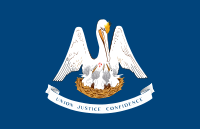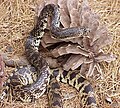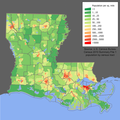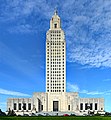The Louisiana Portal Louisiana (French: Louisiane [lwizjan] ⓘ; Spanish: Luisiana [lwiˈsjana]; Louisiana Creole: Lwizyàn) is a state in the Deep South and South Central regions of the United States. It borders Texas to the west, Arkansas to the north, and Mississippi to the east. Of the 50 U.S. states, it ranks 20th in land area and the 25th in population, with roughly 4.6 million residents. Reflecting its French heritage, Louisiana is the only U.S. state with political subdivisions termed parishes, which are equivalent to counties, making it one of only two U.S. states not subdivided into counties (the other being Alaska and its boroughs). Baton Rouge is the state's capital, and New Orleans, a French Louisiana region, is its largest city with a population of about 383,000 people. Louisiana has a coastline with the Gulf of Mexico to the south; a large part of its eastern boundary is demarcated by the Mississippi River. Much of Louisiana's lands were formed from sediment washed down the Mississippi River, leaving enormous deltas and vast areas of coastal marsh and swamp. These contain a rich southern biota, including birds such as ibises and egrets, many species of tree frogs—such as the state recognized American green tree frog—and fish such as sturgeon and paddlefish. More elevated areas, particularly in the north, contain a wide variety of ecosystems such as tallgrass prairie, longleaf pine forest and wet savannas; these support an exceptionally large number of plant species, including many species of terrestrial orchids and carnivorous plants. Over half the state is forested. Louisiana is situated at the confluence of the Mississippi river system and the Gulf of Mexico. Its location and biodiversity attracted various indigenous groups thousands of years before Europeans arrived in the 17th century. Louisiana has eighteen Native American tribes—the most of any southern state—of which four are federally recognized and ten are state recognized. The French claimed the territory in 1682, and it became the political, commercial, and population center of the larger colony of New France. After a brief period of Spanish rule, Louisiana was returned to France in 1801 before being purchased by the U.S. in 1803; it was admitted to the Union in 1812 as the 18th state. (Full article...) Entries here consist of Good and Featured articles, which meet a core set of high editorial standards.
Grapico is a caffeine-free, artificially flavored carbonated soft drink with a purple color and a grape taste that is sold in the Southeastern United States. When introduced in 1916, the product quickly became a success, which in part was due to implying that Grapico contained real grape juice even though it contained fake juice. In the spring of 1926, J. Grossman's Sons sold the Grapico business to the Pan American Manufacturing Company in New Orleans. Pan American continued J. Grossman's Sons' improper practice of implying that Grapico contained real grape juice and lost the right to use the word "Grapico" to designate their artificial grape drink in 1929. Although the J. Grossman's Sons line of the brand had ended, the Grapico brand continued on through Alabama businessman R. R. Rochell and his Birmingham, Alabama-based Grapico Bottling Works. R. R. Rochell had first become a wholesale syrup customer of J. Grossman's Sons in the summer of 1917 to serve the Alabama soft drink market. By the time Pan American had lost their artificial grape drink name in 1929, Rochell was selling bottled Grapico in Alabama, Florida, Georgia, Mississippi, and Louisiana. (Full article...)Selected article -The Louisiana Purchase Exposition, informally known as the St. Louis World's Fair, was an international exposition held in St. Louis, Missouri, United States, from April 30 to December 1, 1904. Local, state, and federal funds totaling $15 million (equivalent to $509,000,000 in 2023) were used to finance the event. More than 60 countries and 43 of the then-45 American states maintained exhibition spaces at the fair, which was attended by nearly 19.7 million people. Historians generally emphasize the prominence of the themes of race and imperialism, and the fair's long-lasting impact on intellectuals in the fields of history, art history, architecture and anthropology. From the point of view of the memory of the average person who attended the fair, it primarily promoted entertainment, consumer goods and popular culture. The monumental Greco-Roman architecture of this and other fairs of the era did much to influence permanent new buildings and master plans of major cities. (Full article...)General images -The following are images from various Louisiana-related articles on Wikipedia.
Did you know -
Related portalsTopicsCategoriesNew articlesThis list was generated from these rules. Questions and feedback are always welcome! The search is being run daily with the most recent ~14 days of results. Note: Some articles may not be relevant to this project.
Rules | Match log | Results page (for watching) | Last updated: 2024-04-18 00:10 (UTC) Note: The list display can now be customized by each user. See List display personalization for details.
WikiProjectsTasks
Associated WikimediaThe following Wikimedia Foundation sister projects provide more on this subject:
SourcesDiscover Wikipedia using portals |

Sons of Union Veterans of the Civil War











































































